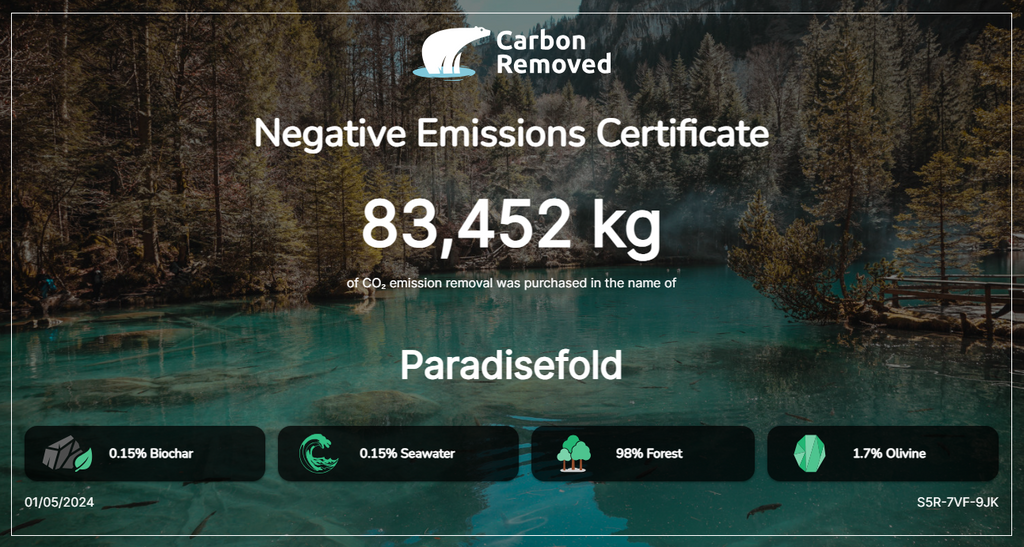
At Paradisefold we understand that everyday choices contribute to our collective carbon footprint. That’s why we’re a carbon positive fashion and lifestyle brand. This means we have helped sequester twice more carbon than we emit. Excitingly, it also means that the more we grow the more we sequester.
The fashion industry is currently responsible for 10% of global carbon emissions, even more than all international flights and shipping combined.
As a core part of this commitment, every year we painstakingly measure our emissions. This includes everything we can measure, from carbon emitted from making silk fabric to the card in our boxes, and last-mile delivery for every single order. This year our measurements showed that we emitted 41,726 Kg CO2e. On that basis we invested in capturing 83,452kg CO2. This means that, with your help, we achieved the following positive metric of 41,726 Kg CO2.
Decoding Carbon Jargon: Removal vs. Offsetting
With all the buzzwords floating around, it is natural to be confused about carbon removal versus offsetting. Offsets are about preventing emissions elsewhere, while removal actively pulls existing carbon from the atmosphere. Removals are therefore a more robust solution to the climate crisis we’re in.
Here is a breakdown of our investments, which we made with our wonderful partners, Carbon Removed.
Our Investments
Last year, we invested in direct air capture technology, bio oil injection (takes waste biomass and turns it into bio oil) and ocean kelp forests (kelp grown on buoys is submerged, benefiting marine ecosystems and sequestering carbon), amongst other methods.
This year, alongside investing in forestation, we also invested in olivine stones, biochar, and seawater electrolysis. Here’s a summary of how some of these methods work. At Paradisefold, we invest in all these technologies (on a relatively tiny scale given our size!) to help move them along.
- Biochar: Biochar enhances soil fertility, retains moisture and sequesters carbon in a stable form for long periods (literally millenia). It is produced by heating waste plant matter at high temperatures without oxygen. This process transforms biomass into a stable form of carbon that can be incorporated into soils. This method takes 2-5 years to be fully delivered and stores carbon for millenia.
- Seawater Electrolysis: This helps restore ocean health by removing excess carbon dioxide and supports the production of clean energy. It is a process that removes carbon dioxide from the oceans, which naturally absorb it from the atmosphere. The captured carbon dioxide is then used to produce green hydrogen, contributing to carbon removal efforts. This method takes 2-5 years to be fully delivered and stores carbon for millenia.
- Olivine distribution: Olivine is a mineral that reacts naturally with atmospheric CO2. Over time it reacts with water and air to sequester CO2 and produce stable silicates, helping store carbon for millenia. This method takes 1-2 years to be fully delivered, 50 years to mature, and stores carbon for millenia.
- Forestation: Planting native trees can naturally sequester carbon dioxide by converting it into biomass, while providing natural ecosystems. We work with partners that plant only native species (no mono-cultures) and ensure that there is no deforestation happening before planting trees. This method dates up to 5 years to be fully delivered and sequesters carbon for decades. A safety buffer is included when planting trees. We double plant and calculate the carbon removal over 5 years.
The challenges of going green in fashion
It’s hard to be green in fashion: industry has a complex supply chain and its emissions occur from the cultivation of raw materials to manufacturing processes and transportation.
Each of these sequestration methods offers unique benefits and contributes to hopefully turning our brand into a net positive for the planet. Your purchases have helped us get to this point. And if you’re wondering what you can do to contribute, here is some advice on conscientious consumption:
- Use apps such as Good On You to understand if and how your favourite brands are moving towards being more sustainable. No brand is perfect, but we recommend focussing on your ethical and sustainability priorities and finding brands that align with yours.
- Choose quality over quantity: invest in high-quality natural fabric that lasts longer, and brands that offer product aftercare, from brands like ours!
- Buy pre-loved: this used to be an anathema to many, but more companies are upping the quality and curation when it comes to pre-loved garments. Brands like Vestaire and Preworn are just two examples we love, from this growing community.
- Support smaller brands trying to make an impact: there are many small brands like ours working to make an impact. One of our very favourite is Sheep Inc, for example, who are also carbon negative and make lovely knitwear!
These are just some of the small steps we can all take to help our collective community contribute positively to the environment. Please comment below and share your tips for how our habits can help shape a more sustainable world.
Thank you for joining us on this journey. 💚




Leave a comment